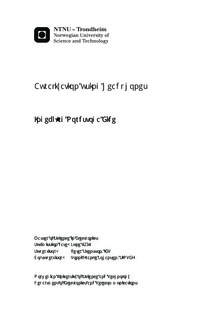| dc.contributor.advisor | Svensson, Peter | nb_NO |
| dc.contributor.advisor | Johansen, Tonni Franke | |
| dc.contributor.author | Eide, Ingebjørg Nordstoga | nb_NO |
| dc.date.accessioned | 2014-12-19T13:47:47Z | |
| dc.date.accessioned | 2015-12-22T11:47:02Z | |
| dc.date.available | 2014-12-19T13:47:47Z | |
| dc.date.available | 2015-12-22T11:47:02Z | |
| dc.date.created | 2012-11-08 | nb_NO |
| dc.date.issued | 2012 | nb_NO |
| dc.identifier | 566407 | nb_NO |
| dc.identifier | ntnudaim:8062 | |
| dc.identifier.uri | http://hdl.handle.net/11250/2370556 | |
| dc.description.abstract | In this report various techniques used to estimate head related impulse responses are compared. The purpose is to investigate the effectiveness of presenting auralization via the QuietPro system's earplugs, and see if sound localization in the horizontal plane is possible. In addition, a theoretical study to relate pinna dimensions to features found in measured head related impulse responses is described. In the theoretical part, impulse responses for 33 left ears found in the CIPIC database were investigated, as an attempt to relate reflection coefficients and time delays associated with reflections from the pinna to physical dimensions of the ear. Unfortunately, no clear connection was found.In the listening test, the participants were sitting in the middle of a circle, surrounded by 36 numbered pieces of paper (either standing on top of e.g loudspeakers or attached to microphone stands) that indicated possible sound directions. 14 subjects performed sound localization tests by listening to three consecutive noise bursts of 150 ms duration with 100 ms silence between. Prior to the experiment, measurements of the subject's head were made and used for customization of the models. The task was to determine which of the 36 possible directions the sound was meant to come from. Seven simulation conditions were evaluated, each including 33 stimuli. Four test stimuli were also presented, resulting in a total of 235 noise bursts for each subject.The results show that the presented methods provide directionality to the stimuli, and that sound localization is possible. However, a significant reduction in localization performance compared to what could be expected for normal hearing conditions is observed. A high number of front/back confusion is reported, and even some instances of left/rigth confusion. Accuracy of the results was not predicted by model complexity, and in some cases it turned out that adding more features significantly degraded the performance. | nb_NO |
| dc.language | eng | nb_NO |
| dc.publisher | Institutt for elektronikk og telekommunikasjon | nb_NO |
| dc.subject | ntnudaim:8062 | no_NO |
| dc.subject | MTEL elektronikk | |
| dc.subject | Akustikk | |
| dc.title | Auralization using headphones | nb_NO |
| dc.type | Master thesis | nb_NO |
| dc.source.pagenumber | 121 | nb_NO |
| dc.contributor.department | Norges teknisk-naturvitenskapelige universitet, Fakultet for informasjonsteknologi, matematikk og elektroteknikk, Institutt for elektronikk og telekommunikasjon | nb_NO |

